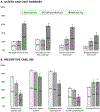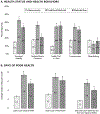Health Status and Access to Care for the North Carolina Medicaid Gap Population
- PMID: 31471506
- PMCID: PMC6744939
- DOI: 10.18043/ncm.80.5.269
Health Status and Access to Care for the North Carolina Medicaid Gap Population
Abstract
BACKGROUND North Carolina remains one of several states that has not expanded Medicaid eligibility criteria to cover all low-income adults, leading to the so-called Medicaid gap, a population ineligible for Medicaid and too poor for premium subsidies through the federal Health Insurance Marketplace. Our objective was to characterize the health care access and health status of the Medicaid gap population in North Carolina.METHODS We combined annual data from the Behavioral Risk Factor Surveillance Survey (2013-2016). Respondents who were uninsured and earning below 100% of the federal poverty guidelines (FPG) were classified as falling within the Medicaid gap and were compared to insured populations below FPG, representing the traditional Medicaid population, and to individuals above the FPG, regardless of insurance status. We reported health care access, receipt of preventive care, and current health status in unadjusted and demographically adjusted models.RESULTS Compared to either traditional Medicaid or above FPG groups, those in the Medicaid gap were 3 times as likely to have no regular source of care and twice as likely to report delaying needed care due to cost. Individuals in the Medicaid gap were more likely than individuals above FPG to report multiple chronic conditions (22% versus 16%) or a functional disability (35% versus 15%), but less likely than the traditional Medicaid population to do so.CONCLUSION While less likely than the traditional Medicaid population to have complex health needs, we found that individuals in the North Carolina Medicaid gap report numerous health care access barriers and lower use of preventive care.
©2019 by the North Carolina Institute of Medicine and The Duke Endowment. All rights reserved.
Conflict of interest statement
Potential Conflicts of Interest. All authors have no relevant conflicts of interest.
Figures


References
-
- Centers for Medicare & Medicaid Services. September 2018 Medicaid & CHIP Enrollment Data Highlights. Centers for Medicare & Medicaid Services website. https://www.medicaid.gov/medicaid/program-information/medicaid-and-chip-.... Published 2018. Accessed December 1, 2018.
-
- Centers for Medicare and Medicaid Services. Medicaid Eligibility & Enrollment Toolkit. Centers for Medicare and Medicaid Services website. https://www.medicaid.gov/medicaid/data-and-systems/meet/index.html. Published 2018. Accessed December 1, 2018.
-
- Medicaid and CHIP Payment Access Commission. Non-disabled adults. Medicaid and CHIP Payment Access Commission website. https://www.macpac.gov/subtopic/nondisabled-adults/. Published 2018 Accessed December 1, 2018.
-
- Kaiser Family Foundation. Explaining Health Care Reform: Questions About Health Insurance Subsidies. Kaiser Family Foundation website. https://www.kff.org/health-reform/issue-brief/explaining-health-care-ref.... Published 2017. Accessed June 1, 2018.
-
- Garfield R, Damico A. The Coverage Gap: Uninsured Poor Adults in States that Do Not Expand Medicaid - An Update. https://www.kff.org/medicaid/issue-brief/the-coverage-gap-uninsured-poor.... Published March 21, 2019. Accessed April 1, 2019.
MeSH terms
Grants and funding
LinkOut - more resources
Full Text Sources
Medical
Miscellaneous
